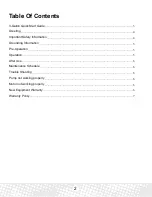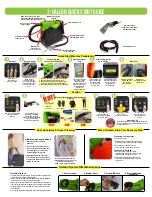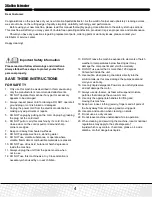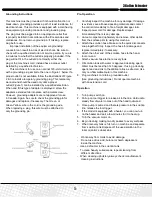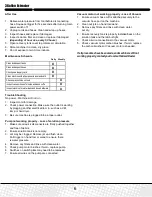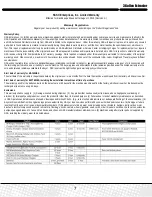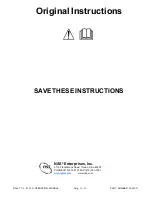
3 Gallon Extractor
5
Grounding Instructions
This machine must be grounded. If it should malfunction or
break-down, grounding provides a path of least resistance for
electrical shock. This machine is equipped with a cord having
an equipment grounding conductor and grounding plug.
The plug must be plugged into an appropriate outlet that
is properly installed in accordance with all local codes and
ordinances. Do not remove ground pin; if missing, replace
plug before use.
Improper installation of the equipment-grounding
conductor can result in a risk of electric shock. Be sure to
check with a qualified electrician or service person if you are
in doubt as to whether the outlet is properly grounded. If the
plug will not fit in the outlet do not modify either the
plug or the machine’s cord, instead have a proper outlet
installed by a qualified technician.
This machine is for use on a nominal 120-volt circuit and
with a grounding plug similar to the one in Figure 1 below. If a
proper outlet is not available, follow the illustrations of Figure
2 & 3 to install a temporary-grounding plug. This temporary
work-around should be used only until a proper
outlet (Figure 1) can be installed by a qualified electrician.
When and if this type of adapter is employed, screw the
adapter’s extended tab into place with a metal screw.
However, grounding adapters are not approved for use
in Canada. Again, be sure to check the grounding pin for
damages and replace if necessary. The Green, or
Green-Yellow, wire in the cord is the grounding wire.
When replacing a plug, this wire must be attached to
only the grounding pin.
Pre-Operation
1. Carefully inspect the machine for any damage. If damage
is evident, save all boxes/packing materials and contact
the carrier immediately to file a freight damage claim.
2. Inspect power cord for damage. Replace/repair
immediately if there is any damage.
3. Vacuum carpet and upholstery and remove other debris
from the surface prior to using this machine.
4. Attach the solution hose. Make sure the quick disconnects
snap together firmly. Inspect the hose for damage and
replace immediately if necessary.
5. Attach the other end of the solution hose to the hand-
tool or wand.
6. Attach vacuum hose to the recovery tank.
7. Fill solution tank with water or approved cleaning agent.
Water must be less than 120 degrees. If using a cleaning
agent, read and mix to the dilution ratios as directed. Use
only non-flammable liquid in this machine.
8. Plug machine’s cord into a grounded outlet
(See grounding instructions). Do not operate machine
with an extension cord.
Operation
1. Turn pump switch on.
2. Pull up on tool trigger to release air in the line. Hold until a
steady flow of water comes out of the hand tool/wand.
3. Once pump is primed and there is pressure in the solution
line, release the tool trigger.
4. If the model is equipped with a heater, you can now turn
on the heater and wait a few minutes for it to heat up.
5. Turn the vacuum motor on.
6. Begin cleaning making two dry passes to every wet pass.
7. When recovery tank is full, turn on machine and separate
from solution tank. Dispose off the used solution in the
toilet or janitor’s closet sink.
- Work away from cords to avoid damage.
- Do not use citrus acid, butanol or harsh degreasers
inside the machine.
- Use a defoamer in the solution tank.
- To clean heavily soiled areas, repeat cleaning from
different directions.
- When cleaning upholstery always check manufacturer’s
cleaning instructions.


